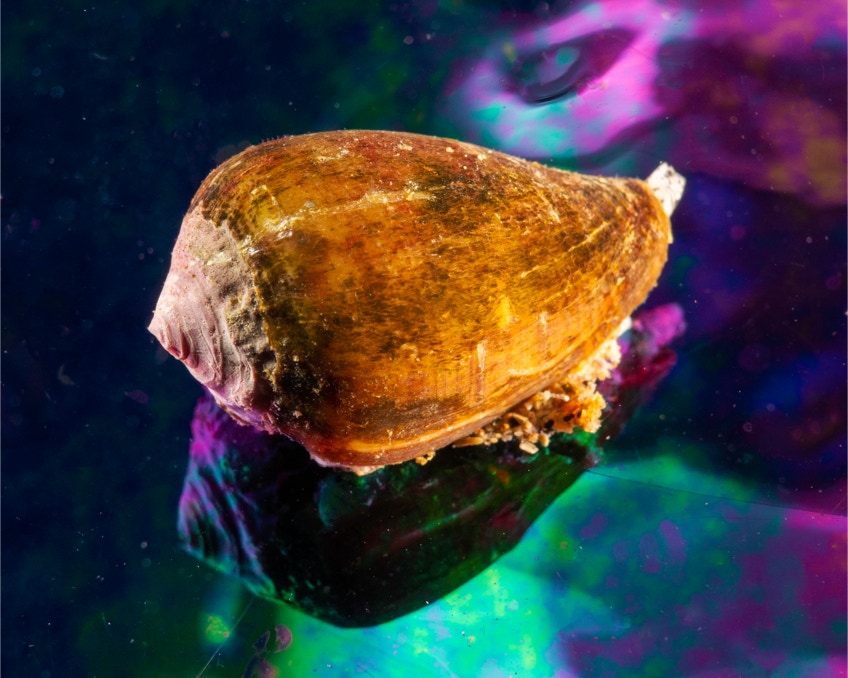January-June 2022 PODs
Bill’s “Pictures of the Day”
from the first half of 2022

Here is a photo of a nice little hermit crab from Puget Sound. He is sitting on the black felt stage and what is strange is that his shell looks like it is covered with eggs. Typically hermit crabs keep their eggs inside their shell; I don't know how this guy's shell got covered.

Another view of my friendly hermit crab which I mistakenly thought had eggs on his back. I should have asked sooner but our friend Dr. Leslie Harris from the LANHM told me that they were indeed the closed polyps of a species of Hydractinia, a hydroid. It turns out that these guys (the hydroid, not the crab) are quite useful in medical research in trying to understand the molecular mechanisms for toxicity by adding some test molecules to the water where the larvae were swimming around. The percentage of larvae that underwent metamorphosis (into polyps) is indicative of toxicity, the more metamorphosis the less toxic the substance is. In any case, thank you Leslie and enjoy.

So on our trip to Honduras I ended up selling both camera bodies and both housings. I ordered a new housing but while it was being made, I shot Nannette's old RX100-V. It has a bad reputation for being crummy for small things but I think this nice little Hermissenda opalescens sitting on the telescope black felt looks pretty nice. In any case, enjoy. This was shot on a Giant Stride trip with friends.

Here is a nice little yellowfin fringehead (Neoclinus stephensae) from a recent trip with friends on the Giant Stride. It turns out that these guys live both in the Eastern Temperate Pacific (Our guys) and in Japan (their guys). According to some recent papers, our guys are the original Neoclinus species of temperate Pacific and some migrated somehow (it seems like a long swim) to the Western Pacific.
Fringeheads of the blenniiform genus Neoclinus are one of several groups of coastal fishes with representatives on opposite sides of the North Pacific Ocean, but not in intervening waters. Available evidence indicates a single dispersal or vicariant event across the North Pacific from this group’s origin in the eastern Pacific, followed by speciation in both the western Pacific and eastern Pacific clades.

Nudibranch means naked gills and this is a picture of the naked gills (brachial plume) of one of our local nudibranchs, a Montereina nobilis (used to be a Peltodoris).

Here is a nice little Cuthona nana sitting on the black telescope felt from our dive a couple weeks ago with friends on the Giant Stride. This is shot with the Sony RX100 V and I am pleased at the outcome. Pretty shallow DOF since I was using a strong external diopter.

Some more shots with the Sony RX (my new housing is here but the weather isn't nice). Here is a nice little Flabellinopsis iodinea (Spanish Shawl) sitting on the stage with the telescope felt. The eyespots on this one are easy to see (normally they are facing away from me).

Here is a nice little cup coral Paracyathus stearnsii Verrill (yet another beasty named after Stearns) from a recent dive with friends on the Giant Stride. Shot with the Sony RX. It turns out that these little guys can tell us a lot about evolution. In an interesting paper (now quite old, Evolution, 1986 “DEPENDENCE OF GENE FLOW ON GEOGRAPHIC DISTANCE IN TWO SOLITARY CORALS WITH DIFFERENT LARVAL DISPERSAL CAPABILITIES”.
Michael E Hellberg showed that if a coral is a broadcast spawner compared to a coral that brood spawns, that the species with planktonic, feeding larvae was less genetically subdivided than the brooding species. Which I guess makes sense.

Here is one of the common snails that we see all over the PV dive sites. This is more with the Sony from our recent Giant Stride trip. Here he is on the dichroic glass stage.

First pic I took of a nudibranch on our recent trip to the Philippines. Here is a nice little Taringa halgerda sitting on the black telescope stage. Gosliner says the rhinophores are black, this one isn’t.

We went diving last Saturday with friends Anastasia, Jeff, Dana and Kelly. It was cold, really cold, but we found the relatively uncommon Babakina festiva, here sitting on the blue glass stage. These guys were well known in Japan since the 1950's but only showed up in California in the late 1970s near Long Beach, suggesting they came over on some ship.











© 2020-2025 Nannette and Bill Van Antwerp